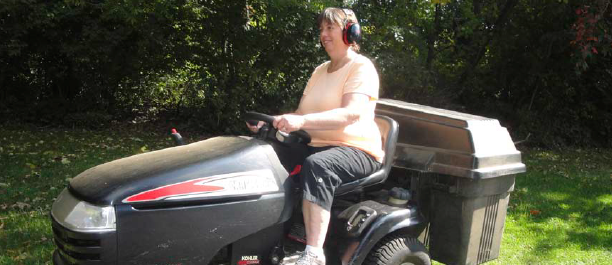
Lawn Tractor Noise Reduction

By Daniel P. Mahoney, Brian D. Mahoney and Jerome Spear
Lawn tractors are a familiar sound throughout suburban neighborhoods as individuals cut their grass each week. Based on a  noise dosimetry study, riding on a lawn tractor presents an average noise exposure in the range of 86.5 to 96.4 dBA. Running the blade adds 1.2 to 7.9 dBA to the overall noise generated by the lawn tractor. Larger deck sizes produce even higher noise levels.
noise dosimetry study, riding on a lawn tractor presents an average noise exposure in the range of 86.5 to 96.4 dBA. Running the blade adds 1.2 to 7.9 dBA to the overall noise generated by the lawn tractor. Larger deck sizes produce even higher noise levels.
Manufacturers can implement feasible engineering controls to reduce the noise levels. Examples include new blade designs, improved mufflers, soundabsorptive materials around the engine housing, lining vibrating surfaces with sound-absorptive coatings and damping of body components to reduce rattling.
Overall, limited noise reductions have been achieved over the past 40 years and progress has been partially offset by increased sales of residential lawn tractors equipped with larger decks. Recent manufacturer research has resulted in some limited noise reduction reduction enhancements marketed to the general public with product costs in the $100 to $200 range (Cancino, 2014).
Historical Research & Standards
As early as the 1970s, Outdoor Power Equipment Institute (OPEI) established a voluntary noise-level criterion at the operator’s ear of 95 dB(A) for riding mowers (EPA, 1974). EPA (1974) published feasible noise-control goals for riding mowers. The study identified four main sources of noise from rotary mowers:
1) Mechanical vibrations: The engine causes the structure of the mower to vibrate and the vibrating structure in turn radiates sound. Vibrations are not generally important with walk-behind mowers, because the deck is relatively stiff, but they do produce substantial noise on riding mowers where there are more mechanical linkages to rattle and a larger structure.
2) Blade: The blade on a rotary mower serves three functions: 1) to lift the grass in preparation for cutting; 2) to cut it; and 3) to lift the cuttings into a bag or distribute them. The blade moves air, thereby generating noise. . . . There are five main mechanisms whereby the blade produces its noise. In the 100 to 500 Hz frequency range, these mechanisms are steady blade lift and drag, blade thickness, fluctuating blade lift and drag due to housing, and fluctuating blade lift and drag due to vortex shed from a preceding blade. In the 500 to 2000 Hz frequency range edge noise due to turbulence shed from the trailing edge of the blade is dominant.
3) Exhaust: Exhaust noise arises from the pulse of exhaust gas emitted each time the engine fires. This source is important because at the present time small engines are not very well muffled.
4) Engine: Engine noise, in addition to exhaust noise, includes intake noise, casing noise, cooling fan noise, valve noise, piston slap and noise from play in the big end of the connecting rod. EPA has not updated its research on lawn mower noise since this original research was published in 1974. Over time, the design of lawn tractors has not changed much and the four main sources of noise remain the same. EPA (1974) outlines three levels of sound-level reduction at a 50-ft radius of the riding mower:
1) Minimum standard: Reduce noise to 74 dBA. This level would require fitting the best available muffler, slowing the engine to 3,400 rpm, fitting a cover around the engine and making provision for cooling air.
2) Intermediate standard: Reduce noise to 70 dBA. This level would require the best muffler, slowing the engine to 3,000 rpm and an acoustic enclosure around the engine.
3) Strictest standard: Reduce noise to 68 dBA. This level would require the best muffler available, reducing engine speed to 3,000 rpm, an acoustic engine enclosure and a quiet blade.
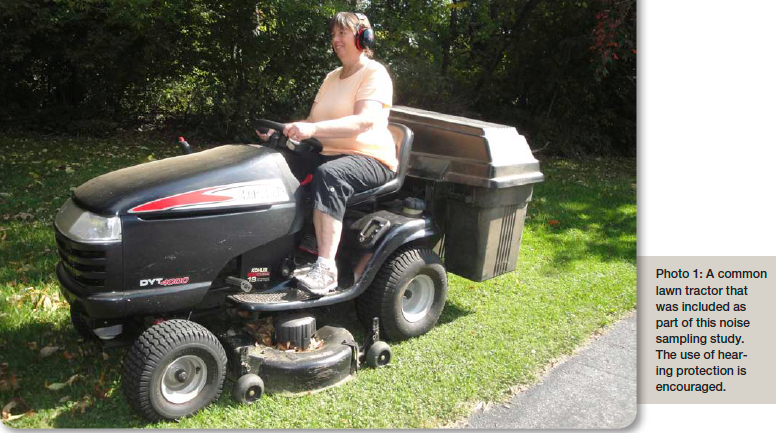
OSHA, NIOSH & ACGIH
Noise Exposure Standards
OSHA has two regulations for noise: one for construction work sites (29 CFR 1926.52) and one for general industry work sites (29 CFR 1910.95). The agency’s current permissible exposure limits (PELs; Table 1) are based on a 5-dB exchange rate. That means when the duration of noise exposure is cut in half the allowable noise exposure is increased by 5 dB.
In addition to OSHA regulations, NIOSH has established recommended exposure limits (RELs) and American Conference for Governmental Industrial Hygienists (ACGIH) has established threshold limit values (TLVs). The NIOSH RELs and ACGIH TLVs (Table 2), are recommended standards that are more protective than the required OSHA PELs. The RELs and TLVs are based on an allowable exposure of 85 dB for an 8-hour period with a 3-dB exchange rate.
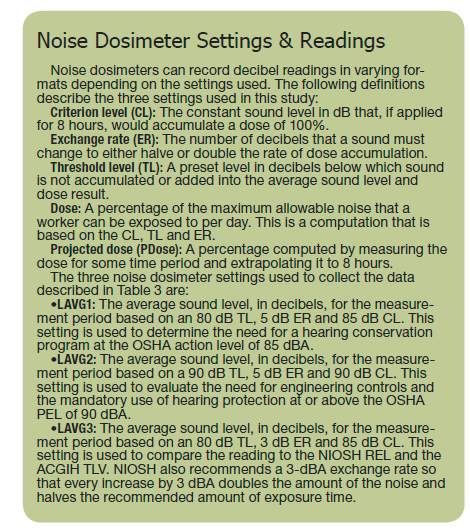 Methodology of Noise Dosimetry Study
Methodology of Noise Dosimetry Study
The noise dosimetry samples were collected during the summer months in a residential neighborhood of 1-acre
lawns. Study participants were volunteers operating lawn tractors as they mowed their grass (Photo 1). The participants were asked to perform their lawn-cutting activities as they typically would and to report any differences from a typical mowing activity. Microphones were attached to each participant’s collar to collect personal noise dosimetry measurements. From start to finish, the lawn mowing task typically took 45 to 60 minutes and the noise dosimetry sample duration ranged from 22 to 73 minutes. Sixteen samples representing four different lawn tractor manufacturers and 12 different lawn tractor models were collected.
Cumulative time-weighted noise exposures were measured using Quest Q200 noise dosimeters. These dosimeters meet the ANSI S1.4-1983 standard for accuracy requirements for a Type II sound level meter. The dosimeters can monitor the three time weighted average settings described here. Dosimeters were calibrated before and after the survey using a Quest QC-10 calibrator. All dosimeters remained within the calibration tolerance levels of ± 0.2 dBA.
Instantaneous sound level readings were taken adjacent to the participant’s head while the individual sat on the lawn tractor with the mowing blade on and off using a 3M Q200 noise dosimeter.
During sampling, it was noted that 11 participants wore either earmuffs or earplugs with EPA noise reduction ratings (NRR) ranging from 26 to 32. Three participants wore no hearing protection and two participants used portable music players with earbuds.
Noise Dosimetry Study Results
The noise dosimetry data and statistical analysis is provided in Tables 3, 4 and 5 (p. 56), and Figure 1 (p. 57). An analysis of the data indicates the following (see “Noise Dosimeter Settings & Readings” sidebar for definitions):
-
- LAVG1 ranged from 86.5 to 96.4 dBA.
- LAVG2 ranged from 68.8 to 96.3 dBA.
- LAVG3 ranged from 88.1 to 96.7 dBA.
- Mower operation with the blade on contributes an additional 1.2 to 7.9 dB (Table 4, p. 56).
- There is a correlation between larger deck sizes and higher decibel levels (Table 5, p. 56, and Figure 1, p. 57).


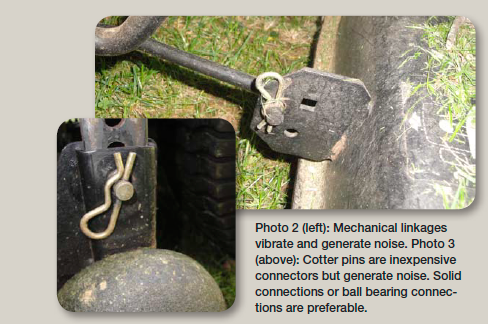 Potential Noise Reduction Strategies
Potential Noise Reduction Strategies
Engineering Controls
Blade Design
The data collected show that turning the mower’s blade contributes an additional noise level of 1.2 to 7.9 dBA. Blade design and the associated air turbulence created by the spinning blades represent important research opportunities to significantly reduce lawn tractor noise. Lyon and Bowen (2007) say:
The airflow around the cutting blades radiates sound according to a dipole model of sound generation; airflow noise from grass-cutting blades increases as (velocity) V6. This means that a 10-dB reduction in noise requires a 17% reduction in speed and a 32% reduction in the impact force between the cutting blade and the grass.
Thus, the physics of sound-level generation places limits on how much noise reduction can be achieved while still maintaining blade speeds that will adequately lift, cut and propel the grass.
Some mower manufacturers have invested in design changes to reduce noise levels. Briggs & Stratton has published some of its research.
Mowers are noisy partly because much of the time they are running faster than necessary to cut the grass. Standard engines typically run at about 3,100 rpm when they are started, then slow as the blade hits resistance in slicing through grass, Briggs said. The rotation of the crankshaft varies from around 2,800 rpm when the blade is cutting thick or wet patches of grass to more than 3,000 rpm where the grass is less dense.
A fuel governor on the new Briggs engine increases the flow of gas to the engine when it runs into denser patches of grass, so the speed remains steadier at around 2,800 rpm, Briggs said, and the use of a flatter blade reduces noise further. (Hagerty, 2014)
Briggs & Stratton’s research team created about 100 blade designs and although in theory the quietest blades would be flat, the flat blades do not create enough suction to lift the grass. The engineers changed the curves to the blades to create suction and added holes to break up the turbulence (Cancino, 2014).

Mechanical Vibrations
Mower decks, engine housings and mechanical linkages are parts that can vibrate and propagate noise (Photos 2, 3). Various options to incorporate into new lawn tractors to reduce noise radiation include the following concepts:
- Construct tractor body hoods and engine covers of plastic or fiberglass materials that have a higher internal damping than sheet metal to reduce noise (Photo 4). This practice is already evident in some manufacturers’ designs.
- Coat mower decks with a damping material. Anticorrosion treatments are already used on tractor decks as an aftermarket treatment. This material may have an added benefit of reducing noise resonance.
- Isolate vibrating parts from the mower structure. Some manufacturers currently use rubber bumpers to isolate the hood housing from the body (Photo 5). This concept can be enhanced with more attention to the design and placement of rubber isolators.
- Reduce vibration of parts by eliminating the use of loose connections tied with cotter pins; instead, replace these with ball-bearing connectors and solid cast parts that do not rattle.
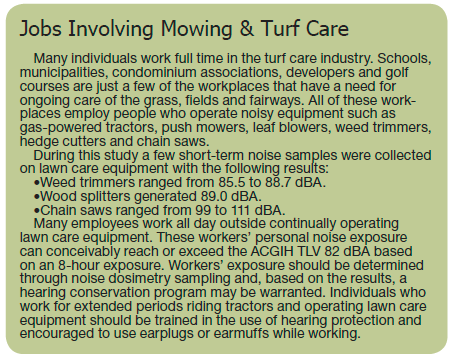 Acoustic Shielding
Acoustic Shielding
Most lawn tractors do not have acoustic shielding to reflect and absorb sound. A 2009 U.S. patent,
“Sound suppression device for internal combustion engine system,” outlines this concept:
A machine is provided having an engine system wherein at least one engine system component with an acoustic reflective surface is surrounded by a jacket configured to absorb sound from at least one sound producing device of the engine system. The jacket includes a sound-absorbing material such as fibrous thermal insulation and an acoustic permeable covering between the acoustic reflective surface and the engine compartment of the machine. The acoustic permeable covering of the jacket may comprise a micro-perforated skin, whereby acoustic energy is absorbed by the sound-absorbing material. (Copley, Callas & Martin, 2009)
Exhaust Silencing
Silencers or absorptive mufflers are provided as a standard feature on all mowers. In most cases these mufflers are designed to absorb and dissipate some of the sound without creating much back pressure on the engine. The use of reflective mufflers or resonators acts to reduce the noise by reflecting and cancelling the sound. However, resonators are not commonly installed as standard equipment on lawn tractors. Combining absorptive and reflective muffler design features can result in more noise reduction.
Table 6 lists the advantages and disadvantages of the two types of mufflers/silencers. For lawn tractors that are only equipped with dissipative mufflers, some manufacturers sell combination dissipative and reactive mufflers. The tractor manufacturer can provide guidance on the operational and physical constraints that impact the selection of a combination muffler. A buyers’ guide from Sound & Vibration (2011) contains a partial list of silencer manufacturers and their websites. A web search can be used to identify current aftermarket muffler manufacturers.

PPE
Based on the noise dosimetry results of 86.5 to 96.4 dBA during the lawn mowing tasks, it is recommended that all individuals operating lawn tractors wear hearing protection so that potential noise exposures are attenuated to below 82.0 dBA.
Additionally, some study participants wore portable music players with ear pieces. These participants said they had to turn up the volume on their players when mowing to be able to hear the music. The use of music players while mowing further contributes to
the potential for noise-induced hearing loss.
Some hearing experts recommend that users set the volume while in a quiet environment then turn the volume down if the listener cannot hear people speaking nearby; avoid turning up the volume to block out noisy surroundings; and limit the amount of time using earbuds or headphones at high volume (Apple Inc., 2016).
Varying styles of hearing protectors exist and each provide different levels of protection. Earplugs are available as foam; protectors are also available as canal caps and earmuffs.
The most common way to evaluate hearing protection is the NRR. Most manufacturers indicate the product’s NRR on the packaging, since it is required by EPA. Appendix B of OSHA’s occupational noise standard (29 CFR 1910.95) requires
that 7 dB be subtracted from the NRR when using A-weighted sound levels. Scientific literature indicates that laboratory-based ear attenuation data for hearing protectors are seldom achieved in the workplace. Therefore, applying an additional safety factor of 50% is recommended to adjust for workplace conditions (Spear, 2011).
NIOSH’s recommendations for derating the NRR are different from OSHA’s protocols. For earmuffs and formable earplugs, NIOSH recommends that 25% and 50% be subtracted, respectively, from the labeled NRR. For other earplugs, NIOSH recommends 70% of the manufacturer’s labeled NRR be subtracted (Spear, 2011).
Administrative Controls
Lawn tractor manufacturers provide a user manual that includes a section on safety. A review of five major lawn tractor manufacturers’ manuals found only one that provided a warning that noise is a hazard that could result in hearing loss. This manufacturer’s manual encouraged the use of hearing protection.
U.S. Consumer Product Safety Commission’s (CPSC, 2013) fact sheet, “Riding Lawnmowers,” is based on voluntary standards and ANSI B71.1-2003. It does not address the potential noise hazard associated with riding lawnmowers, nor does it suggest the use of hearing protection while operating this equipment.
Promoting Quieter Products
NIOSH’s (2016) Buy Quiet prevention initiative encourages companies to buy or rent quieter machinery when new businesses start, or as older machinery is replaced, to reduce worker noise exposure. Designing lawn tractors that generate less noise may offer manufacturers a value-added feature. Differentiating their Buy Quiet products from competitors’ equipment that creates a greater noise exposure may offer a sales advantage that can help overcome the additional costs associated with building a quieter lawn tractor.
Conclusion
Lawn tractors present a potential noise exposure in the range of 86.5 to 96.4 dBA; larger deck sizes are correlated to higher decibel levels. The potential noise exposure from lawn mowers has been recognized for decades and only recently have some companies begun to manufacture equipment with noise-reducing features. Manufacturers can implement engineering controls to reduce
noise levels including new blade designs, improved mufflers, sound-absorptive materials around the engine housing, lining vibrating surfaces with sound-absorptive coatings and damping of body components to reduce rattling.
In addition, manufacturers and CPSC can increase their communication about noise hazards associated with lawn tractors. Until engineering controls are implemented, lawn tractor users are encouraged to wear EPA-rated hearing protection while mowing and operating lawn tractors. PS
References
Apple Inc. (2016). Sound and hearing. Retrieved from www.apple.com/sound
Cancino, A. (2014, May 27). Briggs & Stratton project tackles the grating noise of lawn mowers. Chicago Tribune.
Retrieved from http://articles.chicagotribune.com/2014-05-27/business/ct-lawn-mower-engine-0525-biz-20140524_1_lawn-mower-lawn-and-garden-equipment-neighbor-feuds
Copley, D., Callas, J. & Martin, K. (2009, Dec. 22). U.S. Patent No. 7635048 B2. Washington DC: U.S. Patent and Trademark Office.
Hagerty, J.R. (2014, Mar. 25). Lawn mowers cut decibels for a price. Wall Street Journal. Retrieved from www.wsj.com/articles/SB10001424052702303949704579459822626342770
Lyon, R.H. & Bowen, D.L. (2007). Designing quiet products. The Bridge, 37(3), 11-17. Retrieved from www.nae.edu/Publications/Bridge/NoiseEngineering/DesigningQuietProducts.aspx
NIOSH. (2016). Buy quiet: Background. Retrieved from www.cdc.gov/niosh/topics/buyquiet/background.html
OSHA. (2013, Aug. 15). Noise control engineering concepts and options. OSHA technical manual. Retrieved from www.osha.gov/dts/osta/otm/new_noise/#noisecontroleng
Sound & Vibration. (2011, July). Buyer’s guide to products for noise and vibration control. Retrieved from www.sandv.com/downloads/1107bgnv.pdf
Spear, J.E. (2011). Controlling noise exposure. Retrieved from www.jespear.com/articles/11-10-noise
-2.pdf
U.S. Consumer Product Safety Commission (CPSC). (2013). CPSC fact sheet: Riding lawnmowers (CPSC Publication No. 588). Retrieved from www.cpsc.gov/PageFiles/122050/588.pdf
U.S. Environmental Protection Agency (EPA). (1974,June). Lawn mowers: Noise and cost abatement (EPA Publication No. 550/9-74-011). Retrieved from www.nonoise.org/epa/Roll1/roll1doc19.pdf


